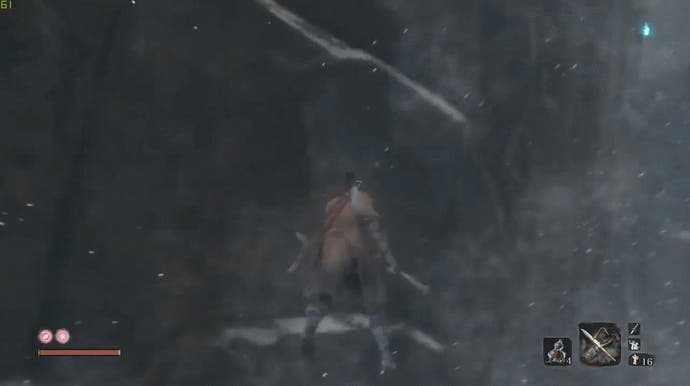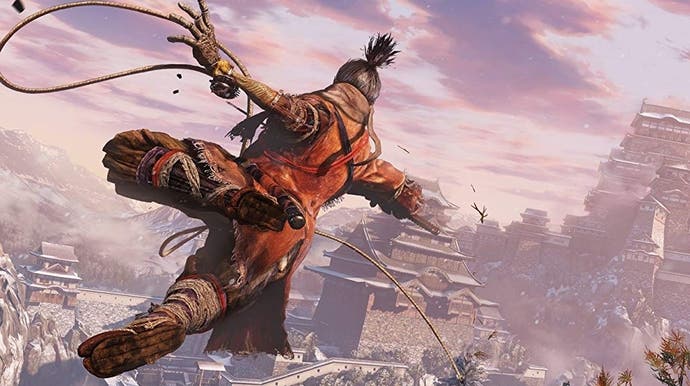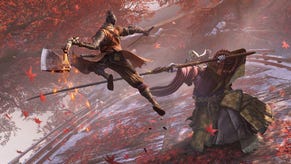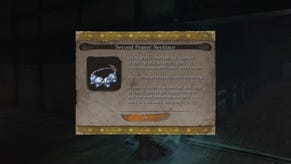Speedrunning Sekiro
And streaming for charity.
In many ways, FromSoftware games are inextricably intertwined with speedrunning and challenge runs. Perhaps it's the fact they're designed to be difficult that makes series veterans long for an even greater challenge, or maybe players create almost insurmountable obstacles purely for the sake of their viewers' entertainment. Either way, Dark Souls and Bloodborne have retained their relevance for years post-release thanks to these self-sacrificing runners. It's no wonder, then, the speedrunning scene in Sekiro is already shaping up nicely.
Souls veteran LobosJR has been running FromSoftware games for years, even having completed runs without healing or levelling up. Although he's a talented speedrunner, he's perhaps best known for his challenge runs, during which he outlines a strict list of rules he must abide by. One of the most iconic examples of this was when he completed Dark Souls using only his character's fists.
"What I love about From's games are their core combat mechanics, and Sekiro has taken these to the next level," Lobos explains. "By basing the combat on 'deflecting', the equivalent of parrying in Souls, fighting has evolved to fast-paced back and forth with an enemy... mastering the combat is trickier than ever, and trying to learn enemy AI is more intriguing."
"I've started out doing some of the more obvious challenge runs just to sharpen my skills: No Healing, No Leveling, etc," he adds. "Now I've moved into speedruns, but later I'll try some seemingly impossible runs like 'Deflect Only', which only allows you to beat an enemy by perfectly blocking them until their posture maxes out. Some runs along these lines may not be possible, but we'll find out."
This idea of impossible runs is largely why Lobos has become one of the most recognisable names in Soulsborne circles, right up there with Distortion2, Elajjaz and VaatiVidya. Even though there's no guarantee a Deflect Only run is plausible at the moment, the fact he's willing to try is one of the things that makes the Soulsborne and Sekiro communities so special. However, despite all of his time running games and the countless challenges he's overcome over the years, he still views Sekiro - and the other Souls games - as astoundingly difficult challenges.
"Anyone experiencing one of the games for the first time has a steep curve to get past to understand how to approach the game. Some of this has to do with complex/unexplained systems within the game, but a lot of it comes from just understanding that you need to learn from every mistake," he says.
"Understanding why you got hit by each attack or why you died to a thing is very important. Approaching it in this way, you can hone your strategy to become entirely based on execution, which is still not necessarily easy, but muscle memory kicks in and carries you to victory after practice."
After years of running Soulsborne, Lobos recently started to experiment with the Shinobi simulator. "Considering we're only a few weeks after launch, the [Sekiro] speedrun scene is constantly changing," Lobos tells me. "New skips are being found, routes are being updated. And the game has two ending points; one of which is maybe 60 or 70 per cent through the 'full' ending's content."
"The goal of a speedrun is to beat the game as quickly as possible, so naturally the majority of people have sought to finish the shorter, [Shura] ending," Lobos explains.
"The longer ending is known as the 'Immortal Severance' route. Additionally, there is an 'All Memories/All Beads' category, which involves killing every boss and collecting every health upgrade item. Not every boss can be played in one playthrough, which means going through the game twice, completing the Shura ending in NG+."
The All Bosses Sekiro run requires multiple playthroughs, drastically differentiating Sekiro from its predecessors. In previous From games, you could fight every boss in a single run if you met certain prerequisites. In this sense, the idea of layered playthroughs introduces one of several intriguing new dimensions to the FromSoft running community.
"Sekiro differs quite a bit from Souls in terms of speedrunning," Lobos tells me. "First off, there are no attributes like Stamina, Strength or Dexterity to choose to level up. There is simply Vitality/Posture and Attack Power. This makes it nice to just rush boss enemies as long as you know how to defend yourself."
"Movement is also hugely different in Sekiro. The grapple, jumping and general speed makes running through areas quicker than ever," he says.
However, it's not just the increased pace of movement that allows runners to storm through Sekiro. "Thanks to wall-jumping, you can skip the encounter with the Blazing Bull enemy at the entrance to Ashina Castle," Lobos explains. "An out-of-bounds fall allows you to skip from the middle of Senpou's forests straight to the mystical location of the Painting Monkeys. And after some considerable testing by the community, a consistent strategy was found to spawn the Great Serpent earlier than intended and skip past a large area of the game."
While there have been skips and exploits in previous From games - you might remember the infamous Bloodborne skip that allowed you to jump straight from Iosefka's Clinic to the Shadows of Yharnam boss fight - Sekiro brings this to a whole new level thanks to its emphasis on speed and mobility. Area traversal has never been so prone to experimentation, so naturally the community has played around with the increased maneuverability and capitalised on their findings.

As a way of giving back to his community, Lobos regularly tries out runs suggested by his fans. "I'm always open to new ideas," he tells me. "I won't do every suggested run, however, just because I've usually done the same or a similar run. The best suggestions take mechanics unique to a game and either change them or throw them out the window. One run in particular I loved was playing Dark Souls while being zoomed in with a bow the whole time. Turns out you can move/dodge/attack all while zoomed in, so I took it upon myself to do a whole run like this." For some people, this might seem like a silly way to play the game, but to Lobos, it's just another way to experiment with something both he and his community love.
And that describes Lobos' streams in a nutshell: his community. Perhaps the best thing about Lobos is his personality and how he interacts with his viewers. Although he's incredibly talented when it comes to Soulsborne and Sekiro, he's a genuine and sincere person who recognises he has an influential platform - something he capitalises on once a year.
"Every May, I raise money for St. Jude and code my own programs that allow the community to add restrictions to my gameplay," he explains. St. Jude is a children's research hospital seeking to fight cancer and other terminal illnesses.
"I even have a program that lets chat type in actions that are input into my game," Lobos explains. "So I did a Twitch & Lobos vs. Dark Souls. Obviously, everyone was immediately draining me of my heals and trying to roll me off cliffs, but it's all for a good cause."













